Home » Articles posted by James Hern (Page 11)
Author Archives: James Hern
EPA Ruling Caps Production of HFCs in Refrigeration
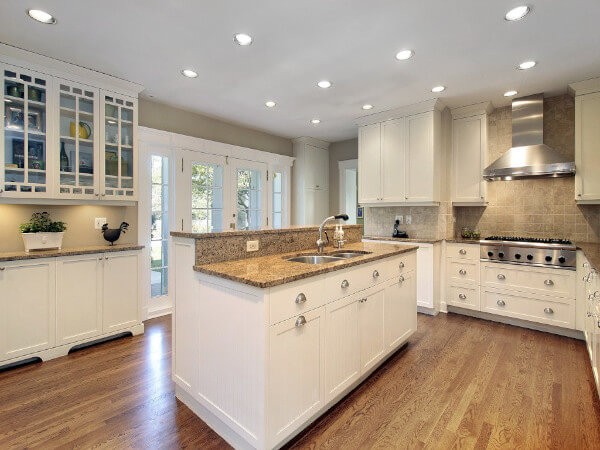
WASHINGTON, DC — In what officials are calling a major step in combating global climate change, the U.S. Environmental Protection Agency has issued a final rule establishing a program to cap and phase down domestic production and consumption of climate-damaging hydrofluorocarbons (HFCs), highly potent greenhouse gases commonly used in refrigerators and air conditioners.
The landmark program, announced today, will phase down the U.S. production and consumption of HFCs by 85% over the next 15 years, as mandated by the American Innovation and Manufacturing (AIM) Act, enacted in December 2020 as part of an effort designed to slow global warming, EPA officials said. HFCs are potent greenhouse gases commonly used in refrigeration and air conditioning equipment, as well as foams and other applications.
The bipartisan AIM Act, backed by a coalition of industry and environmental groups, not only phases down HFCs, but also ushers in the use of more climate friendly and energy-efficient alternatives aimed at saving consumers money while protecting the environment, according to the EPA.
“Today, EPA is taking a significant step forward to tackle the climate crisis,” said EPA Administrator Michael Regan. “Cutting these climate ‘super pollutants’ protects our environment, strengthens our economy, and demonstrates that America is back when it comes to leading the world in addressing climate change and curbing global warming in the years ahead.”
“American companies are at the forefront of developing HFC alternatives and the technologies that use them, and the AIM Act provides these companies additional opportunities to continue to innovate,” Regan added.
EPA estimates that the cumulative net benefit of its action will amount to more than $272 billion from 2022 through 2050, and that the rule will yield cumulative compliance savings for industry. In 2036 alone, the year the final reduction step is made, the rule is expected to prevent emissions of the equivalent of 171 million metric tons of carbon dioxide (CO2) – roughly equal to the annual greenhouse gas emissions from one out of every seven passenger vehicles registered in the U.S., the EPA said. The total emission reductions of the rule from 2022 to 2050 are projected to amount to the equivalent of 4.6 billion metric tons of CO2 – nearly equal to three years of U.S. power sector emissions at 2019 levels.
EPA officials said the agency will work with the U.S. Dept. of Homeland Security to prevent the illegal import and trade of HFCs through an interagency task force led by personnel from U.S. Customs and Border Protection, U.S. Immigration and Customs Enforcement, Homeland Security Investigations and EPA.
The post EPA Ruling Caps Production of HFCs in Refrigeration appeared first on Kitchen & Bath Design News.
Did you miss our previous article…
https://www.conduithardware.com/?p=243
Sustainability Seen Shaping Housing, Remodeling Markets
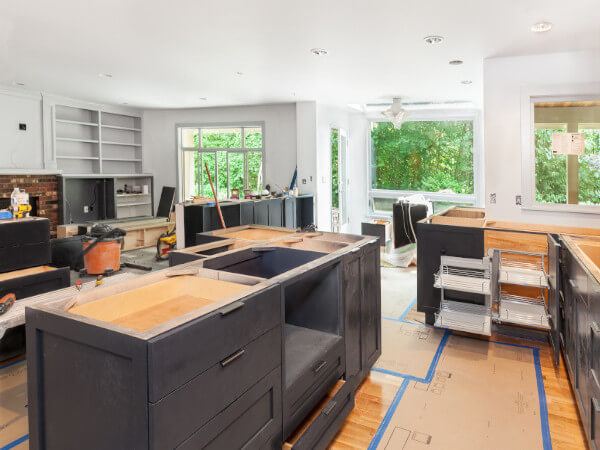
INDIANAPOLIS, IN — A trio of emerging trends in neighborhood design and sustainable living practices should continue to shape the market for new housing and residential remodeling as the “mindset of consumers continues to shift in a dynamic social climate,” according to a new report from the Home Improvement Research Institute.
According to HIRI’s recently issued Future of Housing Trend Report, new and remodeled homes will likely be shaped by a growing homeowner passion regarding issues such as climate change, sustainability and minimalism, resulting “in an increased emergence of eco-friendly materials and 3D-printed technology to designs focused on cultural inspiration and reversible architecture.”
Among the key trends identified by HIRI researchers are the following:
n “Hyper-local neighborhoods”: Architects, developers and local governments are proposing neighborhoods centered on community building and local businesses. These spaces are intended to be car-free, with all necessities reachable via a short walk or bicycle ride.
n Flight from the cities: “As urban centers expand in size and population, consumers are recognizing that their quality of life is suffering — whether that be due to alienation, affordability issues, lengthy commutes or pollution,” HIRI said. As a result, many are moving away from city centers and turning to community-based neighborhoods that provide a sense of belonging while also satisfying the need for convenience and cleaner air.
n Sustainable Housing: With sustainability as a top priority, architects and designers are embracing different eco-friendly concepts, among them “reversible design” (the architecture of structures that can be easily deconstructed, that can be reused or with parts that can be removed and added easily) and 3D-printed housing (homes that offer sustainable and protective construction that avoids structural issues in the case of extreme weather).
“Contemporary consumers are wary of the impending consequences of climate change, and a large number are becoming increasingly aware that simply shifting their lifestyle and practicing ecological mindfulness are likely not enough,” HIRI said. “As a result, many are demanding that brands and creators take the environment into consideration.
n Simplified Living: Building off of the desire for more sustainable living, the emergence of simple, more minimalist design emphasizes homeowners’ functions and needs.
“Contemporary consumers in fast-paced urban centers are looking to balance the demands of their daily lifestyle with a comfortable home environment,” HIRI said. “Many are prioritizing minimalist designs and additional spaces that can optimize and elevate their living situation without compromising aesthetic appeal.”
The post Sustainability Seen Shaping Housing, Remodeling Markets appeared first on Kitchen & Bath Design News.
Trade Associations Urge U.S. Action on Supply Chain Challenges
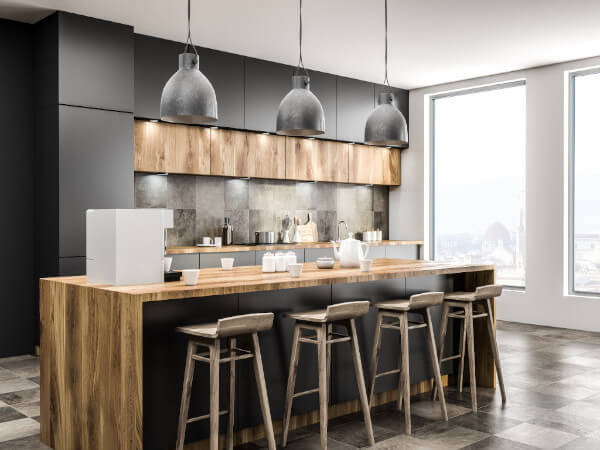
WASHINGTON, DC — The Association of Home Appliance Manufacturers (AHAM), the trade organization representing many of the industry’s leading appliance suppliers, has lent its voice to a four-member coalition of trade associations urging immediate action by the Biden administration and Congress to address ongoing global supply chain challenges.
The Washington, DC-based AHAM yesterday joined the Air-Conditioning, Heating and Refrigeration Institute (AHRI), the North American Association of Food Equipment Manufacturers (NAFEM) and the National Electrical Manufacturers Association (NEMA) in releasing a white paper outlining how supply chain disruptions, which are being compounded by the COVID-19 pandemic, “are hurting the competitiveness of U.S. manufacturers, stalling the U.S. economic recovery (and resulting in) unprecedented damage to the global product supply chain.”
The call for action comes one day after a coalition of workers from across the supply chain warned world leaders that global trade is facing a potential “global transport system collapse” if governments do not restore freedom of movement to transport workers and give them priority to receive COVID vaccines that have been approved by the World Health Organization (WHO).
“The ability to produce and deliver home appliances to consumers has been dramatically hindered by the COVID-19 pandemic and other supply-related issues, creating hardships for consumers and for businesses at every step in the supply chain,” said Joseph McGuire, president and CEO of AHAM. “The result is ongoing shortages of products, materials, components and labor, leading to delays and increased costs,” McGuire said, adding that, in some cases, the supply chain timeline has doubled or tripled.
“This is at a time when consumers are spending more time in their homes and more dependent than ever on home appliances to keep their families healthy and their homes clean,” he said.
The request by AHAM followed a series of meetings between association members and Biden administration staff, centered around issues important to AHAM-member companies, such as the Section 301 China tariffs, Section 232 steel and aluminum tariffs, labor shortages, increased costs for shipping containers and increased shipping times, and semiconductor shortages, AHAM said.
“Combined with increased demand for appliances and equipment, supply chain bottlenecks have negative consequences, including increased costs, lost sales, delayed deliveries of critical products to consumers in the face of supply chain backlogs, and even shutting down manufacturing plants,” the association contended.
AHAM acknowledged that many supply chain issues will require long-term solutions, but the coalition also requested immediate relief from policymakers through tariff removal and fair allocation of semiconductors to all industries.
“Quick implementation of these and other policy solutions may help prevent a continued worsening of the availability of manufactured products in the U.S., while increasing productivity and stemming product cost inflation,” AHAM said.
The post Trade Associations Urge U.S. Action on Supply Chain Challenges appeared first on Kitchen & Bath Design News.
Accessorizing the Kitchen

As homeowners spend more time at home, working and living in their kitchens with their families, the desire for streamlined functionality and a cleaner appearance has only continued to grow. Sought-after details for organizing pantry items, charging electronics and putting everything in its place are just some of the requested details for kitchen accessories and cabinet interiors.
Ease of use is a must for these elements, but aesthetics and beautiful finishes are also part of the mix. Manufacturers have proven to be up to the task, however, as cabinet pullouts don’t just offer function, but do it in style; and accessories deliver the best in function while blending in and even enhancing their surroundings.
Following are some of the hottest trends in interior fittings and kitchen accessories right now.
–Storage accessories are increasingly becoming customized for how homeowners use their space, with removable caddies, utensil storage, adjustable drawer inserts and movable pegs being used.
— Power sources for charging electronics are being hidden away, with customized spaces being created in drawers and nooks for convenient powering up.
–Pullouts now include very specific functional accessories, such as knife blocks and bins that keep items close at hand.
–Reaching into dark cabinets, corner spaces and high storage is becoming a thing of the past, as interior storage units now easily bring the items to the user.
–Using every inch of space is a must in today’s organized kitchens, and spices, sheet pans and cooking utensils find their own spaces in carved-out storage.
–Shelving continues to grow and evolved in the kitchen, with styles ranging from live edge wood to industrial metal.
The post Accessorizing the Kitchen appeared first on Kitchen & Bath Design News.
Homeowners Seeking ‘Spa’ Feel in Bath Remodels, Study Finds
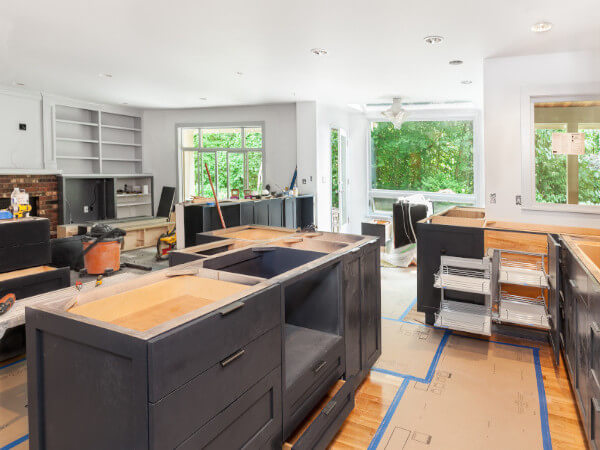
PALO ALTO, CA — U.S. homeowners are increasingly turning to their master bathroom as a safe and peaceful respite from a world that often seems chaotic and threatening, a major new survey has found.
According to the 2021 U.S. Houzz Bathroom Trends Study, two in five surveyed homeowners report using their renovated bathroom for rest and relaxation. The survey also found that cleanliness and a lack of clutter are keys to creating a “spa-like atmosphere” in the bath.
The annual online survey was fielded between June and July to nearly 3,000 U.S. Houzz users who are in the midst of, are planning, or recently completed a bathroom renovation, according to the Palo Alto, CA-based online platform for home renovation and design.
“In the midst of the chaos created by the COVID-19 pandemic, we’re seeing homeowners turn to their bathrooms for respite, creating calming sanctuaries with premium features, hygienic surfaces, and plants and other greenery,” said Marine Sargsyan, Houzz senior economist.
“Given the major changes involved, homeowners renovating their bathrooms are (also) seeking professional help at a growing rate,” Sargsyan added.
According to Houzz, modern, transitional and contemporary styles remain the leading choices for renovated bathrooms. Other features gaining popularity include dimmable lighting and greenery. The percentage of homeowners who relax in their renovated bathroom by soaking in the tub was up six points compared to last year, outpacing the share of those who unwind with long showers, Houzz said.
More than three quarters of homeowners incorporate premium features into their bathtubs and showers, the company added. Top premium features for the bath include soaking tubs, space for two and silent whirlpool baths, while premium shower upgrades include rainfall showerheads, dual showers, body sprayers and thermostatic mixers.
Additional survey findings include:
n Marble in Vogue: Marble is being adopted at a higher rate by renovating homeowners, with increased usage in shower flooring, non-shower flooring and non-shower walls.
n Colorful Vanities: While white continues to be the dominant color chosen across all bathroom features, blue and wood vanities have become more popular over the past year bringing warmth and texture to bathrooms.
n Lighting Upgrades: Homeowners cite both insufficient lighting and no natural lighting as issues before a bathroom renovation, which may explain why more than four in five homeowners upgraded their lighting fixtures this year, Houzz said. Wall lights and recessed lights remain the top two choices in upgraded lighting. However lighted mirrors, pendant lights and chandeliers all inched up in popularity from last year.
n Toilet Technology: More than a third of homeowners who upgraded their toilets during renovations incorporated technology. Bidets remain the most popular tech feature for one in five homeowners, followed by self-cleaning, heated seats, overflow protection and built-in nightlights.
n Lighted Mirrors: Three-quarters of renovating homeowners installed mirrors in their renovated bathroom, with over half installing more than one mirror. Some upgraded mirrors have advanced features, such as LED lighting and anti-fog systems.
n Custom Medicine Cabinets: Nearly one-third of renovating homeowners install custom or semi-custom medicine cabinets, many of which include features such as hidden plugs and lighting on the inside.
The post Homeowners Seeking ‘Spa’ Feel in Bath Remodels, Study Finds appeared first on Kitchen & Bath Design News.
Did you miss our previous article…
https://www.conduithardware.com/?p=201
Honoring Our 2021 Innovators
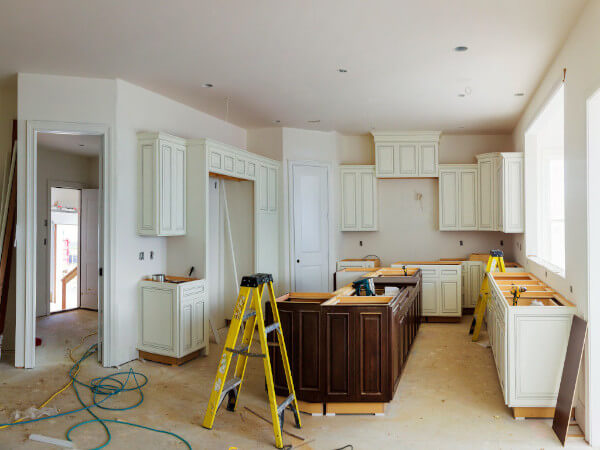
From virtual communication to safety protocols to material and labor shortages, members of the kitchen and bath design industry have had challenges in 2021 unlike any other year prior. Customers and projects abound as the country heads into a post-pandemic era, yet constraints and restrictions require a reliance on acquired knowledge and a constantly changing stream of information.
These challenges can knock even the top industry pros off balance. The key to regaining equilibrium and continuing on a successful path is to be flexible and adjust to circumstances as they arise. While many have weathered the storm of the past few years, others have risen above and not only carried their companies and employees through the mire, but have reached out and helped others in their journey, as well. Industry leaders continue to head committees and associations, educate and mentor professionals with less experience and expertise, and deliver high-quality and innovative design to their clients.
Kitchen & Bath Design News honors these industry leaders in its pages every year by naming The Innovators, a group of industry professionals who are setting the standard for excellence in the design industry. Nominated by their peers and then reviewed by the KBDN nominating committee, the 24 Innovators for 2021 are an exemplary group of individuals who are moving the kitchen and bath industry forward. At the links below, Kitchen & Bath Design News presents its fifth annual class of Innovators.
- Todd Atkins
- Dan Bawden
- Cyndy Cantley
- Madeleine Dymling
- Salvatore Ferro
- Tracy Grosspietsch
- Karen Hockley
- Jennifer Hutton
- Jill Jarrett
- James Justice
- Kimberley Kerl
- Kamer Kosedag
- Rosario Mannino
- Maria Martin
- Mary Miksch
- Lori Miya
- Kevin Mullen
- Leah Muller
- Judith Neary
- Jeremy Parcels
- John Petrie
- Angela Poirrier
- Ginger Rabe
- Nicholas Vanderhovel
The post Honoring Our 2021 Innovators appeared first on Kitchen & Bath Design News.
Did you miss our previous article…
https://www.conduithardware.com/?p=198
Amazing Masters
At its most basic, any master bathroom with a sink, toilet and shower or bathtub can meet essential hygiene needs. However, when asked to do more, designers’ creativity soars to go above and beyond basic to amazing.
Think expanded and/or reconfigured footprints that better accommodate comforts and conveniences. Think unusual and glamorous materials and finishes that transform the aesthetics of the room. Think design elements and products that promote wellness and encourage relaxation within personal sanctuaries.
This month, KBDN asked designers to share amazing master bathroom projects that elevate basic to amazing.
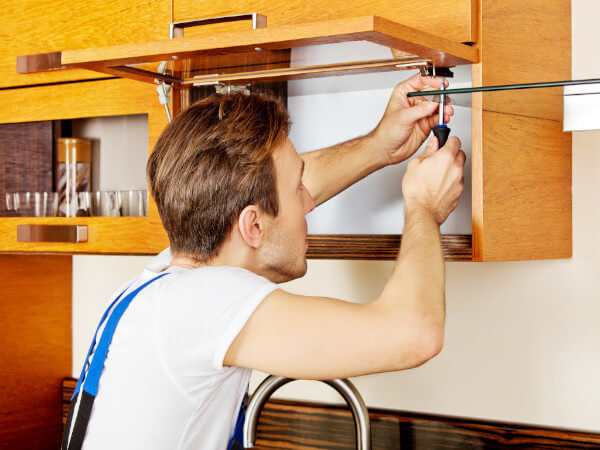
For this large, new master bathroom, Gregory Hall and Emanuel Rodriguez Garcia opted to turn some of the conventional bathroom zones into art pieces. For the tub zone, it’s the white oak slats, while the vanity area includes cabinetry encased in a Calacatta marble frame.
Bathroom ‘Art’
After reconfiguring entirely new interior spaces during the renovation of this four-level home, Gregory Hall and Emanuel Rodriguez Garcia, co-founders of Veritas Design Group & Studio in San Francisco, CA, carved out a large third-floor room designated for the new master bathroom. With such a large footprint, the designers opted to expand some of the conventional bathroom elements to create a spa-like retreat for their clients.
“We took advantage of the grand space and chose to exaggerate some of the typical bathroom ideas, turning them into art pieces,” says Hall.
For example, each of the three zones – the tub, vanity and shower areas – includes some type of ‘art.’ For the tub zone, it’s the white oak slats that loosely separate it from the vanity zone behind it.
“The idea for the slats came about during the reconfiguration of the stairwell,” says Garcia. “With it now located in the center of the house, the slats represent walls rooted in the ground with branches of trees growing up through them. The slats are the pulse of the house and we used them repetitiously throughout to create a rhythm, much like musical scales of a composition.”
The slats are repeated as drawer fronts on the floating double vanity, which is encased in a Calacatta marble frame to further accentuate its suspension.
“Wrapping the vanity with marble makes it feel more special, liked a framed masterpiece on the wall,” says Hall, noting that its lengthy dimension of nearly 16′ adds to the grandness of the room.
LED lighting beneath the vanity and behind the long mirror softly illuminates the entire space, giving it a warm, natural glow. The trio of globular Amora Lighting pendants, accented with black that matches the Samuel Heath wall-mounted plumbing fixtures, feels like puffs of clouds hovering above the countertop with integrated marble sinks. Their oversized dimensions emphasize the abundance of space.
The expansive, curbless double shower, visually on display behind frameless glass that helps define the wet area, showcases handmade Heath Ceramics tile, laid vertically to give prominence to the shower’s height and openness.
“We love the handmade tiles and the human touch they represent,” says Garcia. “So much of the building process is about manufacturing, and these tiles brought back a human sense and connection to the earth.”
One common theme throughout the bathroom is the Calacatta marble, which clads the entire floor wall to wall and serves as the vanity top and accent in the tub area.
“The marble has a very ethereal feel, both emotionally and aesthetically,” says Hall. “Its white background, when mixed with the warmth of the wood, makes it feel like you’re walking on clouds.”
Balancing Old and New
Working in the Pittsburgh, PA community, Michael Jacobs is often challenged to balance old and new.
“Our housing stock is very old,” says the president/owner of Marvista Design + Build in Pittsburgh. “So many homes are over 100 years old, with little additions made here and there. Flow is usually horrendous and rooms no longer reflect modern living.”
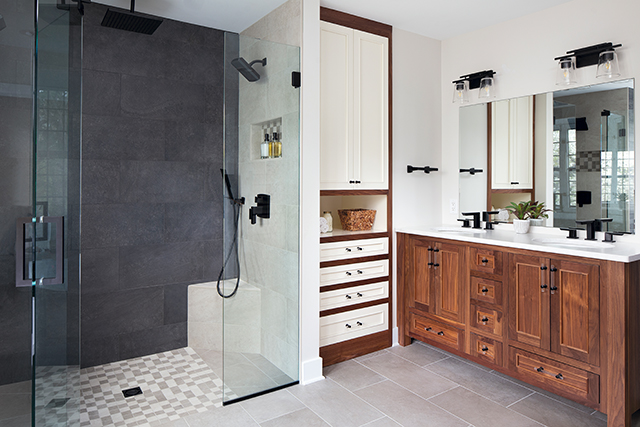
Michael Jacobs and designer Emily Borne added updated finishes that gave this master bath a spa-like aesthetic that respected this older home’s architecture.
Photo: Dave Bryce Photography
Such was the case with this renovation, where Jacobs, along with designer Emily Borne, reconfigured the entire master suite to include a master bathroom with updated finishes that give a spa-like escape. The room respected the home’s architecture within a new layout that better utilized the square footage and eliminated pockets of unused space where clutter and furniture often collected.
As it relates to finishes, the design team created a blend of traditional and contemporary elements.
“Our clients were really attracted to a contemporary design style,” he notes. “However, we wanted to find a way to respect the traditional look of the home. Ultimately, we found a way to pepper in some contemporary details within a traditional shell that resulted in a natural, seamless look.”
For example, custom Plain & Fancy cabinetry with its two-tone walnut/linen finishes features traditional-style mouldings accented with Cambria quartz and contemporary acrylic/matte black Schaub & Co. hardware.
“The juxtaposition of the dark wood and off-white paint looks phenomenal,” he says. “Walnut is such a luxurious finish and it’s making quite a comeback in the kitchen and bath industry. We combined it with matte black hardware, which is also currently trending.”
Jacobs’ clients also wanted to maintain a separate tub and shower. The former, a Signature Hardware freestanding unit, is set off by original, refurbished leaded glass windows. The latter, a walk-in, curbless design, includes a bench. To tie them together, Jacobs and Borne accented each with Matte Black Brizo plumbing fixtures and dark Watered Silk Italian porcelain tile. Three-dimensional tiles behind the tub are stacked, while large-format tiles in the shower are set flush and are combined with contrasting tile in a lighter colorway. A coordinating mix of mosaics accentuates the floor and niches.
“Emily did a great job of selecting several different tiles that all come together,” he says.
As it relates to layout, the designers focused on creating a space in which the homeowners could move about freely.
“In all of our designs, we focus on having room to walk around,” he explains. “We pay attention to aisleways and pinch points, so for this bathroom we designed towel storage next to the double vanity. We also created a make-up area in the master bedroom where she can get ready while he uses the bathroom. A separate toilet area, with a luxury automated toilet, also gives the homeowners the ability to move in, around and out of the area in a semi-private way.”
Modern and Bold, Yet Timeless
To maintain the spacious feeling of this relatively roomy master bathroom, Ethan Levy chose to clad the floor and an accent wall with large-format 24″x48″ porcelain tile from MSI’s Oxide Collection.
“The large tiles minimize grout lines that can make a space feel smaller,” says the CEO of Design Depot in Englewood, NJ.
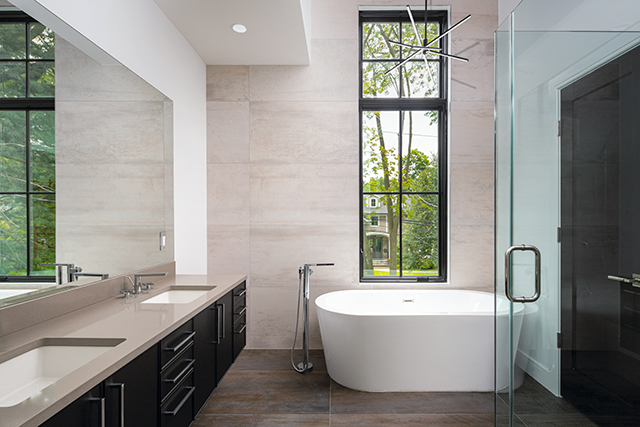
The large-format porcelain floor and accent wall tiles, in contrasting light and dark colorways, set the tone for this master bathroom designed by Ethan Levy, who was tasked to create a space with a modern and bold design theme.
Photo: Nadav Havakook
The light and dark Blanc and Iron tiles also make a statement for the space, where Levy wanted to create a modern and bold theme that was up to date with current trends, yet remained neutral enough to stay in style for years to come.
“The color of the black vanity and the dark floor, which is almost black with some rustic texture, are very bold choices,” he says. “But the lighter wall tile and the quartz vanity top bring some neutral tones back into the space.”
The contrast between the floor and wall tiles is also on-trend with what the designer sees happening in many bathrooms he designs.
“Clients currently seem to be liking a contrast between dark, such as black, and light, such as white or light gray,” he indicates. “They also like to add some warmth back into the room, which is important so the space doesn’t feel cold. In this bathroom, we did that with the floor tile. It isn’t just plain black. It has some rusty, earth tones in it that warm up the concrete-look tile. A wood finish on a vanity would be another nice way to warm up a space that has a black tile floor.”
Black, in general, is also trending as selections for design elements and materials such as tile, vanities and fixtures, as illustrated in this master bathroom that showcases the nearly 8′-long, semi-custom Bellmont Cabinet Co. vanity.
“The vanity is really impressive and its length helps to stretch the feeling of the space,” says Levy. “We also added a little lip around the edge of the doors that adds some detail so they aren’t the standard slab-style door that is so common these days.”
Additional black elements include penny round shower floor tiles and a tall, black-framed window that extends from the top of the freestanding tub to nearly the top of the 12′-tall ceiling. A matte black, contemporary-style chandelier hangs suspended in front.
“We had some extra space in the section of the bathroom with the tub so we extended the window,” he says, noting its black frame matches the rest of the windows in the home. “It brings in a lot of natural light, which is important when you’re using dark colors.”
Bold Black and White
Based on her client’s request for a black and white master bathroom, Lauren Lerner obliged with a mix of the contrasting tones where light tones, represented by the freestanding tub and walls, set the stage for the stunning tile selections showcased on the floor and shower walls.
“The black and white theme led to the tile selections for the room,” says the designer, founder/principal designer, Living with Lolo in Scottsdale, AZ.
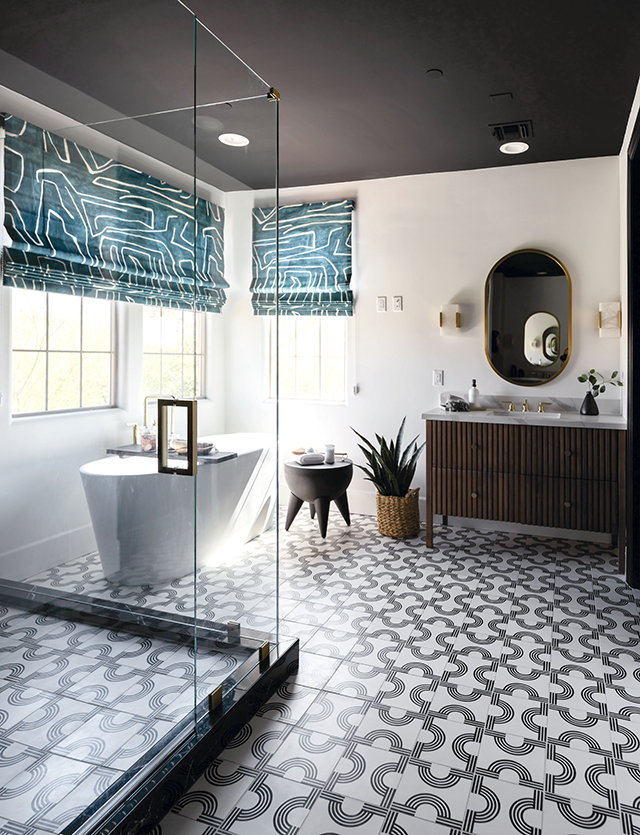
Based on her client’s request for a black and white master bathroom, Lauren Lerner mixed the contrasting tones, where light tones, represented by the freestanding tub and walls, set the stage for the tile selections showcased on the floor and shower walls.
Photo: Life Created
The floor, Saba Tile’s Savoy Snow & Ebony polycoated cement tiles, unite the two hues in a graphic pattern that runs throughout the entirety of the space, including into the shower.
“Our client loves the tile and how it adds personality to the space,” she explains, adding that its pattern layout also helps to elongate the room.
In the shower, Marble Tech’s Port Laurent Nero Marquina porcelain tile echoes a resemblance to its natural stone inspiration. Its large 24″x24″ dimensions further the likeness.
“We wanted it to appear to be an actual marble slab,” she explains. “The large tile size allowed us to achieve that look.”
Dark hues are furthered with the ceiling and custom alder vanity crafted by a local cabinet maker. Lerner topped the vanity with Vadara’s Calacatta Sevella quartz, which serves as a ‘light’ representative given its icy, glacial inspiration and predominantly ‘snowy’ background.
While black and white was the overriding color combination, the designer brought in a pop of color with the teal window shades.
“We wanted to bring in some additional color and texture, and since the master bedroom has a lot of teal, we pulled the color into the bathroom with the window treatments,” she says.
Technology also played an important role in the renovation of this master bathroom, where the shower includes a Kohler DTV digital shower system that controls multiple shower experiences from one interface.
“This client, like many of our clients, likes to have high-tech automation in their bathroom, as well as the rest of their home,” she says. “This shower system can be programmed for each user so the homeowner and his wife can have their own unique experience. When he pushes his setting, the shower automatically goes to his preferences…his water pressure, his temperature, his music, etc.”
This client also loves his Kohler Veil intelligent toilet, especially the built-in wash modes and heated seat.
Nature on Display
Cecelia Daniels’ clients have four kids and they lead very busy lives. And while they liked their home, they wanted a renovation that better matched their lifestyle and spoke to their personal tastes. As it relates to their master bathroom, the remodel also needed to aesthetically reflect the room’s physical location.
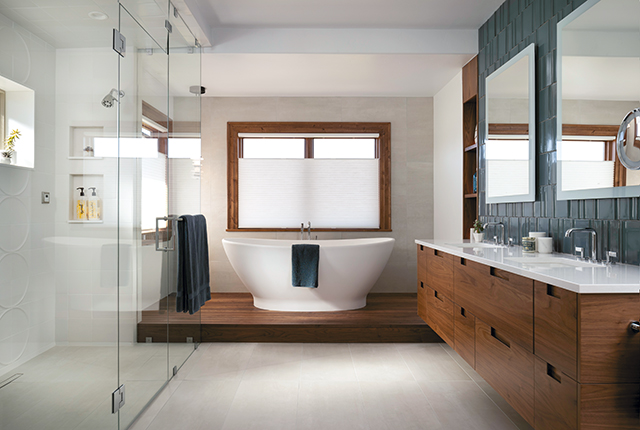
Cecelia Daniels, along with Kimball Modern and Skycastle Construction, deliver several special elements in this bath, including a mix of handmade tiles that sheath the shower and vanity walls and a stone soaking tub on a wooden platform that elevates its status.
Photo: Dane Cronin
“Their private bath is located at the far end of the house,” relates the associate project manager/senior architectural designer at Rodwin Architecture in Boulder, CO. “It’s essentially an oasis removed from the hustle and bustle, so we wanted it to feel that way…calming, bright and peaceful.”
Designing an escape such as the one she created for this family is a common request for many of her clients.
“Though our clients have different priorities and styles, they seem to all have one common goal when it comes to their private baths…escape,” she says.
While she quips about providing all bathroom doors with sturdy locks, she does indicate that the bathroom is one place in the home where it’s acceptable to be alone.
“We like to provide a pleasant space for our clients to reset and recharge so they can cultivate the right mindsets to tackle their busy days,” she says.
With those goals in mind, she – along with interior designer Kate Van Sluyter from Kimball Modern, general contractor Brandon David at Skycastle Construction and principal Scott Rodwin, AIA – included several special elements, such as the mix of handmade Ann Sacks tiles used throughout the space. For example, MADE Modern Moon Cotton tiles sheath the shower wall while a combination of Peak and Valley tiles in the New Lagoon colorway highlight the vanity wall.
“These materials, along with the hand craftsmanship of the floating [walnut] vanity [by The Artisan Shop] and matching open shelving unit, provide a very natural, earthy feel that balance the room’s straight, crisp lines, such as those of the glass shower enclosure,” she explains. “They put nature on display.”
Daniels further flaunted nature by situating the MTI Baths’ stone soaking tub on a wooden platform that elevates its status.
“It seemingly transports you to another time and place where you can imagine soaking outside…somewhere remote that is surrounded by nature,” she explains, adding that the Hubbardton Forge Cairn pendant light suspended near the tub enhances the feeling with its mesmerizing stacked ‘stones’. “The soothing colors – the rich wood, matte whites and warm greens and blues – evoke a spa-like quality. These, combined with organic textures such as natural wood grains, imperfect circles and metamorphic movement in the floor tiles that carry up the tub wall, add to the elemental feel of the space.”
Next-level Spa Retreat
While the goal of creating a spa-like retreat for a master bathroom isn’t necessarily an unusual request these days, Rodney Palmer and Glynis Wood collaborated to ensure that this new-construction space showcased a variety of luxurious products and finishes that provided next-level experiences with distinctive his/her oases, a walk-in closet and even a balcony where their clients can enjoy their morning cup of coffee.
“Everything about this house is unique,” says Palmer, AIA/principal partner, Cornerstone Architects in Austin, TX.
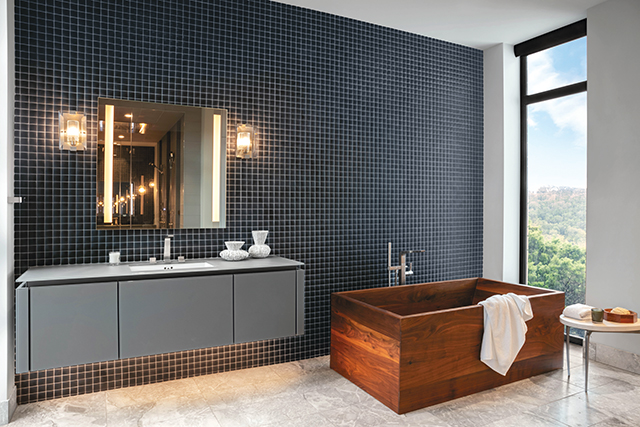
This luxury oases by Rodney Palmer and Glynis Wood includes a Vichy shower with six custom-positioned showerheads that release a calming flush of water onto a leathered granite floating bench, a double-steam shower with a 48″ rainhead showerhead and his/her handheld showerheads and body sprays, and a wooden focal-point tub.
Photos: Cate Black Photography
“The homeowners gave us a lot of free rein so we were able to select unusual products, materials and finishes,” adds Wood, ASID member, Glynis Wood Interiors, also in Austin.
For starters, they included a Vichy shower. Typically seen only in commercial settings, the table shower heightens in-home spa services with its six showerheads – custom positioned to the proportions of their clients’ bodies – that release a calming and cleansing flush of water onto a leathered Black Granite floating bench. To further enhance the ambiance, they clad the room with a variety of Ann Sacks wall and floor tile, including dimensional tile as an accent.
“The Vichy shower is very cave-like,” remarks Palmer. “We wanted to create a lot of warmth, depth and intimacy, which we achieved with the tile.”
The Vichy shower is accessed via the double steam shower, which includes its own well-appointed amenities, such as a 48″ rainhead showerhead and his/her handheld showerheads and body sprays. Also clad in several selections of Ann Sacks tile, Palmer actually reconfigured it after Wood specified the tile.
“We wanted to maximize the tile dimensions,” he explains, in reference to the rectangular and hexagonal tiles. “We didn’t want to have any slivers or irregular pieces so we redesigned the spacing and columns based on the tile.”
To each side of the shower, Palmer and Wood designed his/her oases. His side includes a vanity and toilet room while hers has an added feature of a Bath in Wood of Maine focal-point walnut tub.
“That tub was the first thing I bought for the whole bathroom,” says Wood. “It’s my favorite feature because it’s so unexpected.”
To highlight the tub, the team included an accent wall in Ann Sacks’ Context Pillowed Mosaic Metallic Black.
“A lot of materials within the space are neutral…except for this wall,” says Palmer. “It’s a major accent for the room. We chose the dark shade so the tub ‘pops’ against it. Plus, the dark color helps tone down the light that flows in from the windows.”
The floating gray vanity, topped with a glass countertop and accented with LED lights below, echoes the darker shades within the Grigio Perla floor tile.
“The floor is a really unusual gray marble,” Wood describes, noting that it also sheaths his side of the bathroom as well as the walk-in closet. “I fell in love with its color.” 
The post Amazing Masters appeared first on Kitchen & Bath Design News.
Did you miss our previous article…
https://www.conduithardware.com/?p=189
Todd Atkins
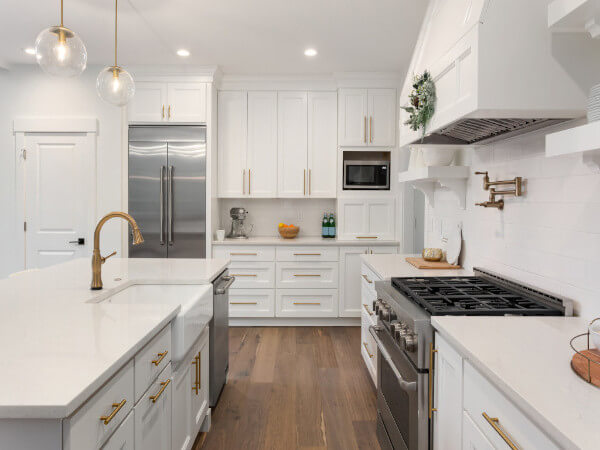
As the kitchen designer of The 2021 New American Home, Todd Atkins, senior kitchen designer for the Phil Kean Design Group, in Winter Park, FL, showcased his mastery in mixing unexpected styles and aesthetics to create a leading-edge, yet classic kitchen design that is ahead of its time. This “modern” kitchen showcases soft, warm tones and a balance of modern and traditional elements that work together to achieve a high-end, sophisticated setting.
For example, a traditional 10′ walnut hutch acts as the anchor of this modern kitchen, recessed into the 14′ wall and surrounded floor-to-ceiling with a soft white quartz. The refrigerator/freezer and pantry are hidden behind a high-gloss, champagne-colored panel wall, framed in a carbon-stained 8″ Alder wood surround. The surround is duplicated on the range wall that blends classic inset base units painted in cream with mirrored upper cabinetry and a custom hood in chevron walnut panels with bronze metal trim. Then, kitchen finishes are rounded out with a gold faucet, refrigerator pulls in gunmetal, brushed nickel sconces, silver island pendant and gold pulls on the range wall cabinetry and on the walnut hutch.
The seasoned interior architect and designer’s new take on combining finishes and textures is exciting innovation in kitchen design, note colleagues.
The post Todd Atkins appeared first on Kitchen & Bath Design News.
Did you miss our previous article…
https://www.conduithardware.com/?p=186
The Invisible Workplace Crisis
There’s little doubt that COVID-19 has radically transformed the residential remodeling, housing and kitchen/bath landscape.
For one thing, remodeling demand is reportedly at record highs, with both short- and long-term forecasts overwhelmingly positive. At the same time, new lifestyles emerging as byproducts of the global pandemic are proving responsible for the current mindset driving home design, product preferences and consumer purchases. Homes have literally been transformed, doubling in many cases as offices, schools, playgrounds and multi-generational residences. Wellness, sanitization, biophilic design and an emphasis on outdoor living have become more pronounced than ever. Multi-functional kitchens and eco-inspired baths remain high on the list of remodeling projects favored by homeowners.
But there’s more to the impact of the coronavirus than simply that.
Businesses on every rung of the product-distribution chain have been forced in the past 18 months to essentially reinvent themselves, implementing virus-mitigation strategies ranging from masking and showroom protocols to an increased emphasis on remote employees and digital-connectivity tools. Product costs have risen sharply, while labor shortages have been exacerbated and supply chain disruptions continue to result in project delays. Home prices have also spiked amidst shrinking inventories and a pronounced flight from the cities.
And now there’s yet another COVID-related issue that’s increasingly impacting the residential construction trade: the profound impact that the public-health crisis is having on workplace mental health.
Indeed, throughout the months-long pandemic, employees and business owners alike have faced an unprecedented confluence of issues threatening their physical and mental wellbeing. Routines have been disrupted, relationships strained, fears heightened over personal health and the health of loved ones. Feelings of isolation have led, in many cases, to a pervasive sense of loneliness and vulnerability. Anxiety, uncertainty, depression and stress have similarly taken a toll. While many remote employees are handling the disruptions well, others miss the sense of connectedness they had once in offices, factories and showrooms.
The subject of workplace mental health has been thrust into the public spotlight in recent months, particularly now that the nation is experiencing a resurgence of the coronavirus amidst contentious differences regarding issues like masking and vaccinations. And now, with no end to the pandemic seemingly in sight, many people are experiencing a sense of “horizonlessness,” the lack of a firm reference point regarding the future, as well as a sense of déjà vu regarding potential job losses and business closures.
All of this has had a cumulative effect. Indeed, workplace mental health is being described by experts as an “invisible crisis” that has yielded a palpable rise in chronic pain, fatigue, substance abuse, loss of productivity and suicide.
It has also yielded, thankfully, some decisive action.
The National Association of Home Builders, for example, is actively attempting to change the culture regarding mental health awareness by providing resources tailored to employees and business owners in the residential construction trade. As evidence, the NAHB recently launched a multi-faceted initiative focused on helping business owners support healthy work environments and turn mental health awareness into action. As part of that effort, the NAHB partnered with other trade groups and mental-health experts to develop specific tools for business owners to learn more about employee wellbeing, help eradicate the stigma associated with mental illness, and encourage employees to utilize the resources available to help navigate this complex, sensitive issue.
This effort is more than simply commendable. Indeed, it should serve as a model for others.
Business leaders and industry trade associations have an important role to play when it comes to balancing worker health with the ROI that can be realized by focusing on wellness through the lens of lower healthcare costs, reduced absenteeism and increased productivity.
Corporate management should fully understand why mental health is essential to the success of their companies. They should also understand how they can be proactive in incorporating mental health into a company culture that prioritizes the wellness of employees as much as it does revenue and profits. 
The post The Invisible Workplace Crisis appeared first on Kitchen & Bath Design News.
Did you miss our previous article…
https://www.conduithardware.com/?p=183
My Phone is Ringing, and This is Why
I am frequently contacted by business owners who are dissatisfied with their digital marketing efforts. The number one reason I hear time and time again is “My phone isn’t ringing.” The owners want more customers, and their marketing efforts are not achieving that goal.
I have pinpointed three categorical reasons this disconnect occurs. If you are spending money on digital marketing and your phone isn’t ringing, read on for a guide to garner more customers. As an advocate for businesses, my hope is to empower owners with educational insight from independent sources so they can make informed decisions with confidence.
Reason #1: Agencies Selling the Work Wanted
To understand the business/agency disconnect, we must explore the typical marketing agency business model. Most are structured around a staff that includes website builders, social media marketers, graphic designers and copywriters who often work on search engine optimization as well. The website builders are project oriented and need an ongoing supply of work to justify their pay. Conversely, the social media work is typically ongoing.
The most common occurrence I see is building an entirely new website for a client when a less expensive update would suffice. If a website builder is needing new work, unscrupulous agencies will begin pitching websites to all their prospects, and statistically they will get work. I personally discovered one agency that designed a website template programmed to increase additional billings and work. They created internal coding on the website that overrides automatic search engine optimization (SEO) from working so they could bill for SEO work separately after the website build. I had the uncomfortable task of informing the client of my discovery and the cost of re-coding the website.
Green Light: An agency that produces documented reporting that shows your website needs SEO work and provides a market share report that demonstrates a deficiency in your website visitors compared to your competitors visitors is an indicator they have the expertise and have done research to support the suggestion. Reporting that clearly shows the deficiencies that need correction is a good sign.
Red Light: When the agency relies only on the visual appearance of the website, or wants to produce a website that is photography based with no supporting analysis of your site. Websites that serve as a photo album with little or no written content will not increase new visitors from Google searches.
Hint: You can check your website’s SEO score for free on many websites. This one scores on a scale of 100: https://www.seobility.net/en/seocheck/. This is the perfect tool to utilize to double check agency website work for integrity. This tool (or a similar third party) should also serve as a deliverable to achieve prior to final payment for website work.
Hint: If you are rebuilding your website, insist on an Americans with Disabilities Act (ADA) compliant website. This ensures disabled visitors can access all the information. Websites are legally required to be ADA compliant; additionally, ADA-compliant websites are more SEO friendly, as the requirements of ADA and SEO overlap. Following is a link to a free ADA website checker: https://wave.webaim.org/
Reason #2: Owners Believe Digital Marketing is a Finite Process
Digital marketing is an ongoing process of pivoting with the additions of experiences on social media. Instagram Live video feeds and Facebook Business Suite are a few of the latest 2021 additions. Additionally, building traffic to a website is an ongoing process of deliberate growth dictated by Google, Bing and others. All of these show your content based on algorithmic updates that change how they choose, and who to show, your content. To add to the complexity, your competitors are actively adding content to drive visitors in tandem.
I demonstrate this to clients by showing them their market share of the products they offer, as it is an effective benchmark. For example, the search terms “cabinet hardware” and “kitchen cabinet hardware” total 124,000 per month. If your website generates 4,000 monthly visitors, you have 3% of the total market. By showing this data in numerical form, it speaks a language most owners can understand and they can then develop a budget. After a website is built, there is work to be done on the SEO side, digital advertising, or both, to drive people to it.
Red Light: Business owners who think a website just needs to exist to increase visitors, or they sporadically post on social media with no brand campaign.
Green Light: Professionals who have market share reports to determine the growth potential and the credentials to grow, and will supply references for website SEO initiatives. Social media posting plans that encapsulate more than one post type, ie: Stories, videos AND Feed posts.
Hint: Consistent Blog Posting is the perfect vehicle to connect with your customers and provide new content that search engines want.
Reason #3: The Marketing is Lacking
Targeting the correct audience is easier than ever with the amount of demographic and geographic data that every digital platform collects. When advertising on Google, Bing or social media, the success is in the details. If you are spending on digital advertising, you need to be guided by the reporting that shows the success rate by your audience demographics and geographical location. If your phone is not ringing, dig deeper into who exactly is being targeted to view the ads and adjust it accordingly.
Hint: Request reporting that shows the detail of the audience, the platforms the ads were shown on and the geographic locations.
A consistent brand identity provides consumers with the confidence of knowing the caliber of your products and the service associated with it. Does your social media brand mirror your website and printed collaterals? Does the customer experience stand up to the message? Are your employees educated on your brand identity? Having a solid, well-defined brand identity that clearly demonstrates your unique value is crucial. It ensures the customers are receiving the brand experience they expect.
Hint: Train your employees to ask customers qualifying questions. How did you find us? How was your first experience with us? How can we improve?
Savvy business owners view marketing as an extension of their business, and managing it with loyal partners and a staff that is accountable is a pathway to success. Trust your gut if there is any hesitation on your part and educate yourself with the help of third-party consulting when needed. Digital marketing is complex and is a powerful tool to grow your business, and make your phone ring. 
Denise Grothouse has an extensive background in international business, branding and marketing. She specializes in digital and social platforms and integrating them with traditional marketing and branding strategies. No stranger to the kitchen and bath industry, she is best known for her work as chief brand officer of Grothouse, Inc., and is the current president of the marketing firm Perfect Six.
The post My Phone is Ringing, and This is Why appeared first on Kitchen & Bath Design News.
Did you miss our previous article…
https://www.conduithardware.com/?p=180